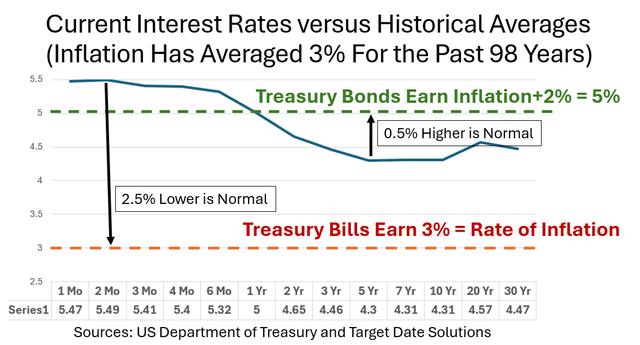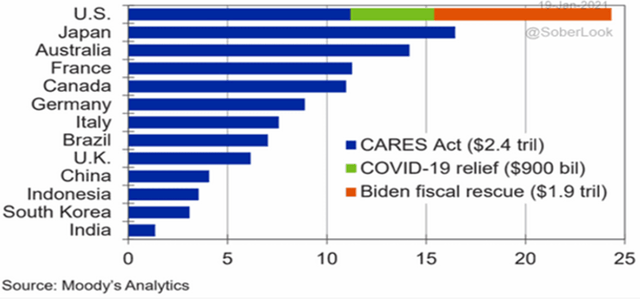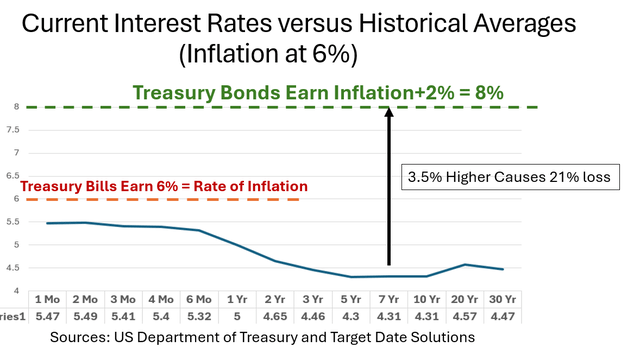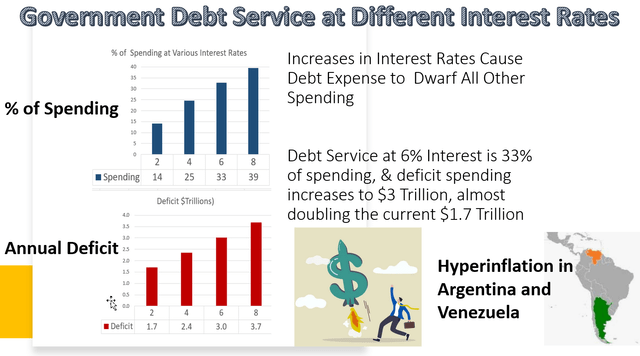Everyone expects the Federal Reserve to “pivot” – to lower interest rates – primarily because inflation appears to be under control. But the economy and stock market are on an upward trajectory, so they don’t need stimulation.
So, the real question becomes “Where should interest rates be now?” History can be our guide. Over the 98 years from 1926-2023, inflation has averaged 3%, so about the current level. Treasury Bills have yielded the rate of inflation and Treasury bonds have returned 2% above inflation, about 5%.
As shown in the following, Treasury Bills currently yield 2.5% more than the historical average so it’s reasonable to expect them to decline IF inflation remains at 3%. But long-term government bonds are earning 0.5% less than the historical average, so long-term rates can be expected to increase, and to increase more than 0.5% if inflation increases.
US Treasury and Target Date Solutions
Why the departures from averages?
The Federal Reserve controls the short end of the yield curve. It sets short term interest rates. These rates are currently high by historical standards because the Fed is fighting inflation, so it wants to slow down the economy. Lowering interest rates would stimulate the economy and stock market, risking higher inflation.
Investors set long term interest rates and they expect interest rates to decline so they’ve priced in lower yields that create an inverted yield curve that is not normal. Investors normally demand higher yield for taking on the risk in long term bonds. Inversions don’t last long and usually precede a recession. It makes no sense for investors to buy riskier bonds that pay less.
If inflation increases
$5 trillion in COVID spending is working its way through the economy and will create inflationary pressures.
Moodys Analytics
For sake of discussion, let’s say inflation increases to 6%. It was at 9% not too long ago in July of 2022. If that happens, long-term government bond yields will increase to 8% (2% above inflation). This 3.5% increase will generate a 21% decline in bond prices. And there would be little change in short-to-mid term Treasury Bill yields.
US Treasury and Target Date Solutions
The increase in long-term yields would be necessary to attract investors. As explained in America’s biggest bond buyers aren’t buying bonds, China and the Federal Reserve – the 2 largest buyers – are not buying currently, so “ Without these two seemingly bottomless sources of demand for American bonds, Uncle Sam has to offer higher yields than it otherwise would have, to get the money it needs from investors.” The Treasury issues bonds to finance the deficit.
The debt spiral
Interest on our $34 trillion debt is $870 billion, which is 2.6% of the debt because the Fed has engineered ZIRP – Zero Interest Rate Policy. $616 billion of the $870 billion is paid out of $4.4 trillion in tax revenues and the remaining $354 billion is added to the deficit, which is running around $2 trillion in total.
If inflation increases, debt service crowds out other spending, like Social Security, and increases the deficit, as shown in the following:
Target Date Solutions
Conclusion
We all want to believe that inflation is under control. If it is, short term rates will come down to approximate inflation. But long-term rates are currently below their historical average of 2% above inflation, so they will trend upwards.
If inflation increases, long-term bond yields will increase significantly and a debt spiral will begin. Preparing for this possibility is discussed in my “ When Stocks and Bonds Won’t Do.”
Read the full article here


